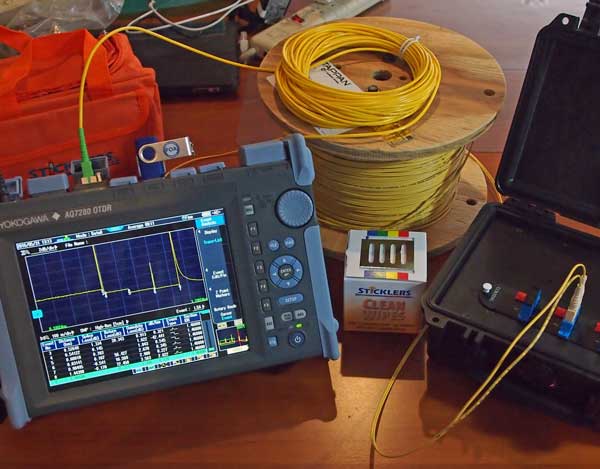Checking Out the Advantages of Optical Fibre Evaluating for Enhanced Interaction Solutions
The relevance of optical fibre screening in modern communication systems can not be overemphasized, as it serves as a structure for making certain network reliability and efficiency. This proactive testing strategy has extensive ramifications for signal top quality and operational efficiency, increasing the inquiry of how these methods add to lasting sustainability in an ever-evolving technological landscape.
Significance of Optical Fiber Testing
The significance of optical fiber screening can not be overemphasized in today's data-driven environment. As organizations progressively rely upon high-speed data transmission for daily procedures, the integrity and performance of optical fibre networks are critical. Checking makes certain that these networks can support the large quantities of information created and transmitted seamlessly, fostering effective interaction and connection.
Optical fiber screening offers numerous critical functions, including verifying setup high quality, recognizing potential mistakes, and establishing total system efficiency. Normal screening can stop pricey downtimes and solution interruptions, enabling organizations to maintain operational connection. It helps in compliance with industry criteria and guidelines, making sure that fibre optic installments fulfill needed specifications for safety and integrity.
In addition, testing can enhance the long life of fibre optic systems. By proactively identifying problems such as signal loss, attenuation, or adapter failures, companies can attend to problems prior to they intensify, thus prolonging the life of their infrastructure. In recap, optical fibre screening is not simply a technical demand but a critical financial investment that enhances network integrity, enhances efficiency, and eventually sustains the growth and efficiency of modern interaction systems.
Key Checking Methods

OTDR is an important method made use of to identify faults, action splice losses, and assess the general stability of a fiber optic web link. By sending a pulse of light down the fibre and examining the mirrored light, service technicians can determine locations of faults and examine the network's efficiency over lengthy distances.
Insertion loss testing measures the amount of signal loss that happens when light passes via a link or splice. This method is essential for verifying that links satisfy specific loss limits, which is essential for preserving ideal performance in communication systems.
Optical return loss screening measures the quantity of light showed back in the direction of the resource as a result of imperfections in the fibre or connections. High return loss worths show far better efficiency and reduced signal degradation.
Together, these screening approaches provide an extensive evaluation of fibre optic networks, ensuring their reliability and functionality in diverse interaction applications.
Influence On System Efficiency
Efficient optical fibre testing directly affects the total performance of communication systems. By guaranteeing the integrity of fibre optic wires, screening recognizes possible faults such as attenuation, splice loss, and connector imbalance. These problems can substantially deteriorate signal top quality, bring about disruptions and reduced data transmission rates.

In addition, regular optical fiber testing adds to lasting system sustainability. It allows very early detection of deterioration, permitting timely upkeep and upgrades before major failings occur. This not only lengthens the lifespan of the facilities but likewise makes official website certain that communication systems stay affordable in terms of performance.
Cost-Effectiveness and Performance
Cost-effectiveness is an essential factor to consider in the release and maintenance of optical fibre networks. Carrying out durable optical fiber testing procedures can dramatically reduce operational expenses by recognizing concerns before they escalate into significant troubles. robotic vision. By finding mistakes, depletion, and other performance limitations early, companies can stay clear of pricey repairs and downtime, which can disrupt services and cause earnings loss
Moreover, reliable screening approaches streamline the installment process, allowing technicians to function better. This translates to decrease work costs and faster task completion times. additional resources Advanced testing devices, such as Optical Time Domain Reflectometers (OTDRs), makes it possible for an exact assessment of fibre top quality, guaranteeing that only ideal products are utilized, thereby decreasing waste.
Regular screening also adds to better source allotment. By recognizing the network's performance, companies can make educated choices regarding upgrades and growths, making sure that financial investments are made where they are most required. In summary, optical fiber testing enhances cost-effectiveness and effectiveness, sustaining the long-lasting sustainability and competitiveness of communication systems in a significantly requiring market.
Guaranteeing Long-Term Dependability
Executing rigorous optical fibre testing not only improves cost savings and functional efficiency yet additionally plays a crucial role in making sure the long-term integrity of interaction networks. Regular screening practices, including attenuation and data transfer evaluations, help identify prospective destruction in fibre efficiency before it causes service disruptions.
By using innovative screening methodologies, network operators can pinpoint faults or weaknesses in the fibre facilities, enabling prompt removal. This aggressive strategy decreases downtime, ensuring that communication systems remain functional and efficient. Normal screening adds to the advancement of a more resilient network, as drivers can adjust and enhance their facilities based on real-time data understandings.
In addition, making sure compliance with industry standards via optical fiber testing reinforces the quality and honesty of the entire communication system. This adherence not just boosts confidence amongst stakeholders yet likewise aligns with regulatory needs, which are progressively strict.
Verdict
To conclude, optical fibre testing functions as an navigate to this site essential component in boosting communication systems. By employing numerous testing methods, such as OTDR and insertion loss analyses, networks can accomplish optimal efficiency and dependability. The proactive recognition of faults not just enhances signal quality yet likewise decreases downtime, ultimately contributing to cost-effectiveness and operational efficiency. Furthermore, adherence to sector standards promotes stakeholder confidence, making sure the long-term sustainability of communication frameworks in a progressively data-driven landscape.